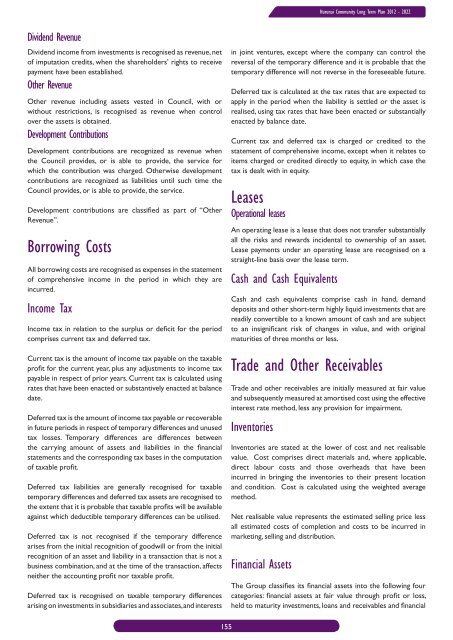Long Term Community Plan 2012-2022 - Hurunui District Council
Long Term Community Plan 2012-2022 - Hurunui District Council
Long Term Community Plan 2012-2022 - Hurunui District Council
Create successful ePaper yourself
Turn your PDF publications into a flip-book with our unique Google optimized e-Paper software.
<strong>Hurunui</strong> <strong>Community</strong> <strong>Long</strong> <strong>Term</strong> <strong>Plan</strong> <strong>2012</strong> - <strong>2022</strong><br />
Dividend Revenue<br />
Dividend income from investments is recognised as revenue, net<br />
of imputation credits, when the shareholders’ rights to receive<br />
payment have been established.<br />
Other Revenue<br />
Other revenue including assets vested in <strong>Council</strong>, with or<br />
without restrictions, is recognised as revenue when control<br />
over the assets is obtained.<br />
Development Contributions<br />
Development contributions are recognized as revenue when<br />
the <strong>Council</strong> provides, or is able to provide, the service for<br />
which the contribution was charged. Otherwise development<br />
contributions are recognized as liabilities until such time the<br />
<strong>Council</strong> provides, or is able to provide, the service.<br />
Development contributions are classified as part of “Other<br />
Revenue”.<br />
Borrowing Costs<br />
All borrowing costs are recognised as expenses in the statement<br />
of comprehensive income in the period in which they are<br />
incurred.<br />
Income Tax<br />
Income tax in relation to the surplus or deficit for the period<br />
comprises current tax and deferred tax.<br />
Current tax is the amount of income tax payable on the taxable<br />
profit for the current year, plus any adjustments to income tax<br />
payable in respect of prior years. Current tax is calculated using<br />
rates that have been enacted or substantively enacted at balance<br />
date.<br />
Deferred tax is the amount of income tax payable or recoverable<br />
in future periods in respect of temporary differences and unused<br />
tax losses. Temporary differences are differences between<br />
the carrying amount of assets and liabilities in the financial<br />
statements and the corresponding tax bases in the computation<br />
of taxable profit.<br />
Deferred tax liabilities are generally recognised for taxable<br />
temporary differences and deferred tax assets are recognised to<br />
the extent that it is probable that taxable profits will be available<br />
against which deductible temporary differences can be utilised.<br />
Deferred tax is not recognised if the temporary difference<br />
arises from the initial recognition of goodwill or from the initial<br />
recognition of an asset and liability in a transaction that is not a<br />
business combination, and at the time of the transaction, affects<br />
neither the accounting profit nor taxable profit.<br />
Deferred tax is recognised on taxable temporary differences<br />
arising on investments in subsidiaries and associates, and interests<br />
in joint ventures, except where the company can control the<br />
reversal of the temporary difference and it is probable that the<br />
temporary difference will not reverse in the foreseeable future.<br />
Deferred tax is calculated at the tax rates that are expected to<br />
apply in the period when the liability is settled or the asset is<br />
realised, using tax rates that have been enacted or substantially<br />
enacted by balance date.<br />
Current tax and deferred tax is charged or credited to the<br />
statement of comprehensive income, except when it relates to<br />
items charged or credited directly to equity, in which case the<br />
tax is dealt with in equity.<br />
Leases<br />
Operational leases<br />
An operating lease is a lease that does not transfer substantially<br />
all the risks and rewards incidental to ownership of an asset.<br />
Lease payments under an operating lease are recognised on a<br />
straight-line basis over the lease term.<br />
Cash and Cash Equivalents<br />
Cash and cash equivalents comprise cash in hand, demand<br />
deposits and other short-term highly liquid investments that are<br />
readily convertible to a known amount of cash and are subject<br />
to an insignificant risk of changes in value, and with original<br />
maturities of three months or less.<br />
Trade and Other Receivables<br />
Trade and other receivables are initially measured at fair value<br />
and subsequently measured at amortised cost using the effective<br />
interest rate method, less any provision for impairment.<br />
Inventories<br />
Inventories are stated at the lower of cost and net realisable<br />
value. Cost comprises direct materials and, where applicable,<br />
direct labour costs and those overheads that have been<br />
incurred in bringing the inventories to their present location<br />
and condition. Cost is calculated using the weighted average<br />
method.<br />
Net realisable value represents the estimated selling price less<br />
all estimated costs of completion and costs to be incurred in<br />
marketing, selling and distribution.<br />
Financial Assets<br />
The Group classifies its financial assets into the following four<br />
categories: financial assets at fair value through profit or loss,<br />
held to maturity investments, loans and receivables and financial<br />
155

















